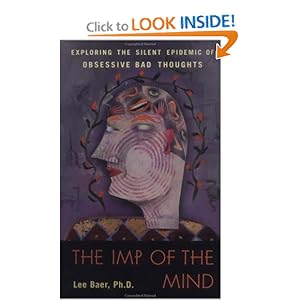 Summary: A thorough review regarding obsessional thought only Obsessive Compulsive Disorder (aka “Pure O”)
Summary: A thorough review regarding obsessional thought only Obsessive Compulsive Disorder (aka “Pure O”)
Purchase Links: Hardcover, Paperback, Kindle Edition
As a psychologist, I am interested in staying updated on current academic literature. I was interested in reading Imp of the Mind by Lee Baer as I was told it focused almost completely on pure obsessional Obsessive Compulsive Disorder or OCD. So many people have the preconceived notion that OCD regularly manifests itself as Jack Nicholoson’s portrayal in as Good As it Gets (e.g. hand washing, stepping on cracks, being cleanly, etc). This can lead to misdiagnosis as obsessional ONLY OCD is actually the most common subtype. Most of the people suffering from this disorder are secretive regarding their obsessional thoughts as the thoughts tend to be violent or distressing, such as harming others or contracting a serious disease. It is unfortunate that uninformed individuals may fear individuals with OCD if their thoughts were disclosed. The one thing that OCD diagnosed people should know is that they are very unlikely, very very unlikely, to ever act on these thoughts, despite what their mind may tell them.
Dr. Baer conducted an excellent overview of obsessional only OCD as well as its’ treatment and course of therapy. He starts by giving an example of a man who became obsessed with having sexual intercourse with animals. He also discusses a priest with extremely sexual thoughts and a women consumed with believing she may be a pedophile. The very difficult thing for OCD sufferers is they are almost always aware that their thoughts are “unwanted” or “disgusting”, hence the “imp” invades the mind and makes the suffer worry more for having disturbing thoughts. The fact is that most people have unwanted thoughts and are able to brush these thoughts aside and think “That was strange” or “What a weird thought!’ For individuals diagnosed with OCD, they become hyper-focused on the thought and the interpretation of said thought, often characterizing themselves as “evil” or “bad” for having the unwanted thought. This can lead to anxiety and depressive symptoms as well.
For well-versed professionals, this book may be a bit repetitive, but for the average reader or family members of people with OCD, Dr. Baer offers good insight into the disorder and takes away the mystery of mental illnesses by being honest and open regarding symptoms and case examples. He also reviews up-to-date literature regarding the use of Selective Serotonin Reuptake Inhibitors (SSRIs) and anti-psychotics at low doses to aid with cogntive treatment for full symptom remission. Not to nitpick, but his chapter on post-partum women and OCD was a bit innaccurate– as most women with obessive thoughts about hurting their new infant would likely better meet the criteria for Major Depressive Disorder with obessional thoughts versus pure OCD, especially if the thoughts occur postpartum. However, this was the only flaw I could find in this informative read, which is overall very accurate and helpful. I found his addition of personality types in OCD to be very interesting as it does seem that most OCD suffers tend to be passive, sensitive, concerned, and moral individuals. He also stated that most were bullied as children which would make for a good follow up study to look at correlational rates of bullied children and OCD development.
